Dee Estuary Birding
Monthly Newsletter...
November 2020 Newsletter
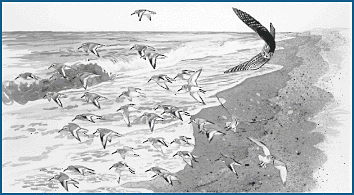
Dunlin - Species Spotlight
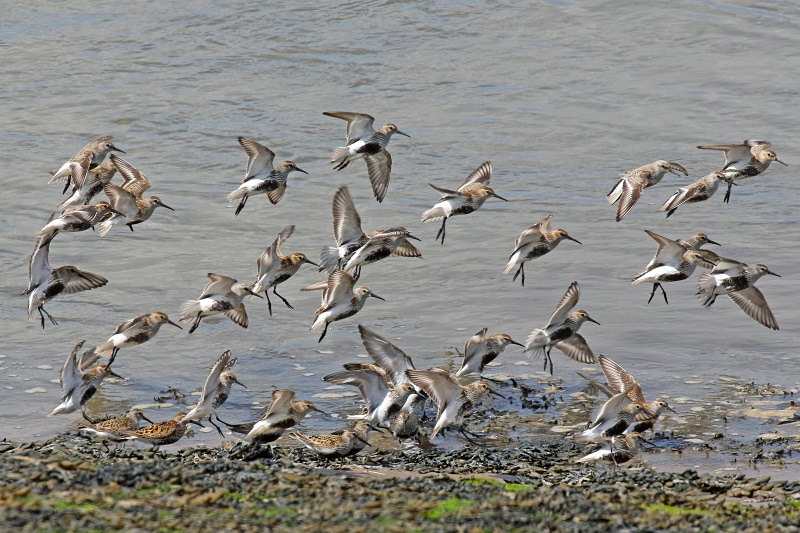
The Dunlin is the most numerous wader along the East
Atlantic Flyway which includes the British Isles. The Dee estuary and
North Wirral are important sites for them but it is our neighbouring
estuary, the Mersey, which holds huge numbers through the winter and is
easily the most important site in the country for them. The latest five
year average has the Mersey Estuary as holding 53,862 Dunlin compared
with the second most important site, the Severn Estuary, which has
30,204. The Dee Estuary/North Wirral, has a more modest 19,657. Dunlins
obviously love the mud of the Mersey which is sheltered and largely
undisturbed, and recent counts include two of just over 68,000 which
were record high counts for the site, and the highest in the
country since 72,113 at Morecambe Bay in January 1992.
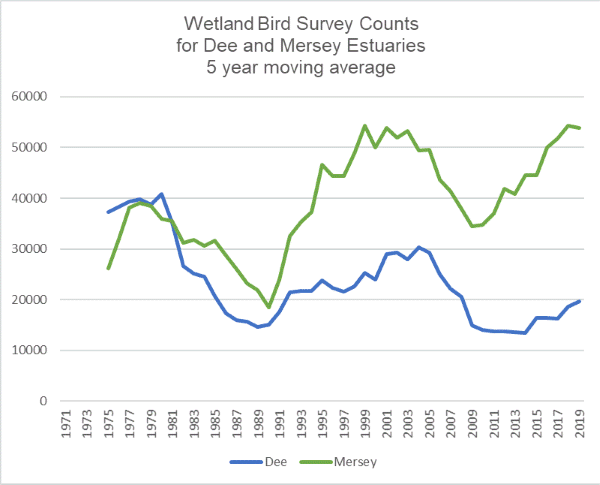
The WeBS counts for the two estuaries both show
similar trends, nearly
all the max annual counts are in winter so the fluctuations reflect
that of the nominate alpina race
which breeds in northern Scandinavia and western Siberia and winters in
western Europe. The trend for the Dee is very similar to that of the UK
as a whole except that the last 10 years numbers have leveled off
nationally rather than showing an increase as the Dee does.
Interestingly, numbers on
the Mersey increased sharply over that same 10 years so becoming
increasingly important for this species and now typically holds 20% of
the UK's population. Whether the declines in the 1980s and again early
this
century effected the whole of the alpina
population
or just those in the UK is not clear. The more recent decline has been
attributed to a run of mild winters with birds short-stopping on the
Waddensea, but recent counts there have also shown declines suggesting
a more widespread drop in numbers - perhaps due to a run of poor
breeding seasons.
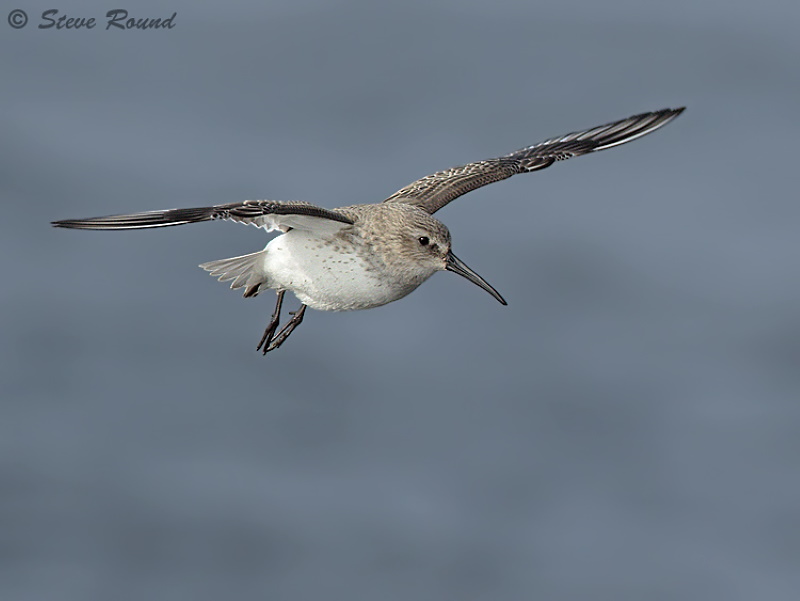
Dunlin Mega-site
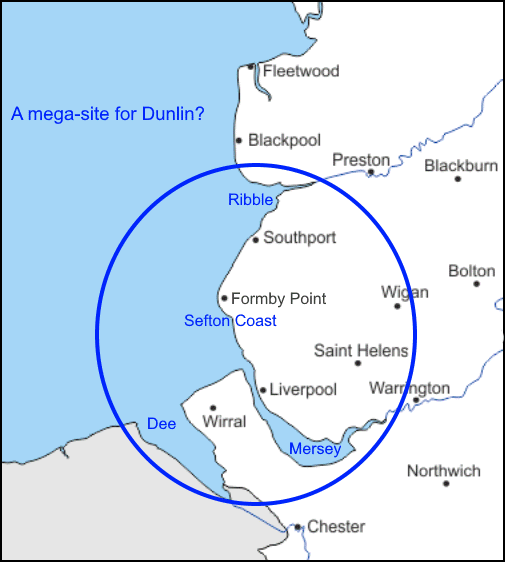
Peak counts for the Dee and Mersey are
nearly always on different months through the winter, suggesting that
there is movement of Dunlin between the estuaries and perhaps they use
it as one big site. But for birds using north Wirral, and a lot do feed
on the mud banks off Leasowe and New Brighton, the Sefton/Ribble Coast
(from Crosby up to the Ribble Estuary) is only a short
flight away and typically holds up to 15,000 wintering Dunlin. Ringing
tells us little about local movements within winters but it does seem
likely that all these estuaries are used as one big mega site.
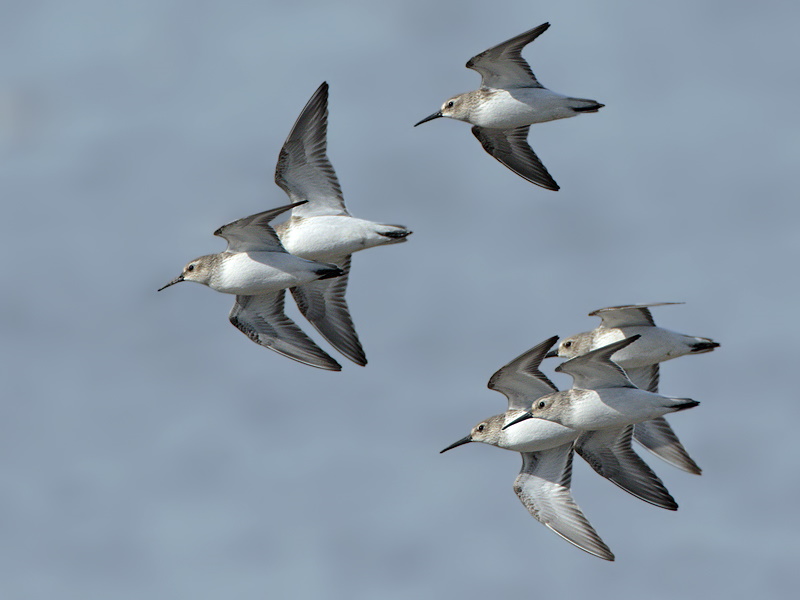
A Winter Refuge
Early February 2012 brought a Siberian blast of cold
air to our shores, but it was even colder further east and Gdansk, on
the Baltic shore of Poland, recorded a temperature of -28șC. It was
bitter at Thurstaston on the 3rd but not quite freezing when I was met
with a strange sight - at least 5,000 Dunlin stretched out in a long
line close to the beach, all the way from Heswall Marsh to the Dee
Sailing club causeway. Unless roosting, Dunlin are always on the move
feeding and flying from spot to spot - but these weren't roosting, they
were busy feeding yet hardly moving and they just looked exhausted!
I've never seen Dunlin behave quite like that before or since but
presumably they must have just flown in to escape the freezing weather
further east. This is an example of how important our west coast
estuaries can be as refuges during abnormally cold weather and
something similar happened when the 'beast from the east' struck in
February 2018 with high numbers of Dunlin on all our local estuaries.
The graph below contrasts the monthly
distribution in a 'typical' winter (2016/17) with that for 2017/18 when
the 'Beast from the East' struck in February. Many other waders,
particularly knot, were similarly affected.
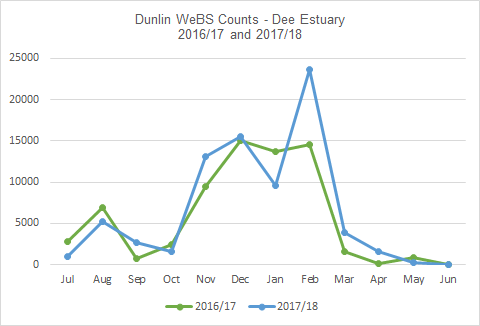
Where to see Dunlin in the Dee Estuary and North Wirral
In the winter Dunlin utilise the whole estuary
wherever there is mud and sand, and even the marshes may be used as a
roost site if the grass is short. I took part in the Low Tide Wetland
Bird Survey in 2014/15 (November to February) and I remember the
counters in the inner estuary expressing surprise at just how many
Dunlin they were seeing off Burton and Parkgate Marshes by the River
Dee Channel, with up to 9,000 completely out of sight from the shore.
But many more can easily be seen at the main high tide roost sites at
Point of Ayr, West Kirby and Hoylake. For some really close encounters
with hundreds of Dunlin it's difficult to beat the rocks at the old
swimming baths site on West Kirby Marine Lake, I've seen as many as
3,000 just a few feet away from the passing walkers along the promenade
and it's a great spot to get some fabulous photographs. These birds
often
feed on the thick mud just to the south of the Marine Lake and you can
get good close views of them from the lake wall.
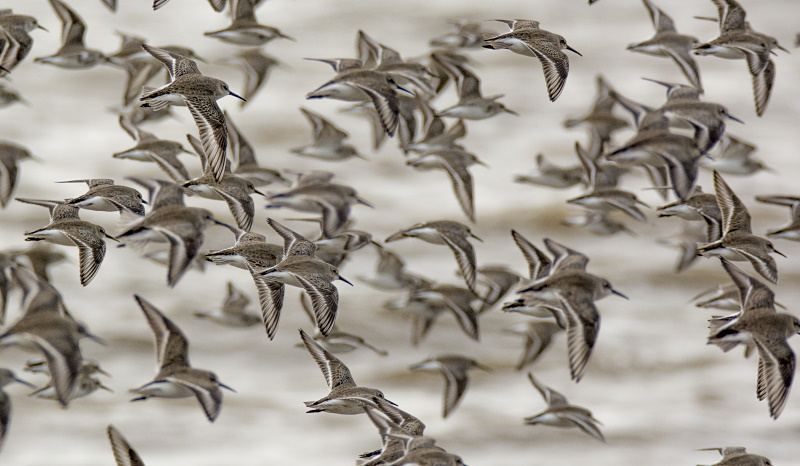
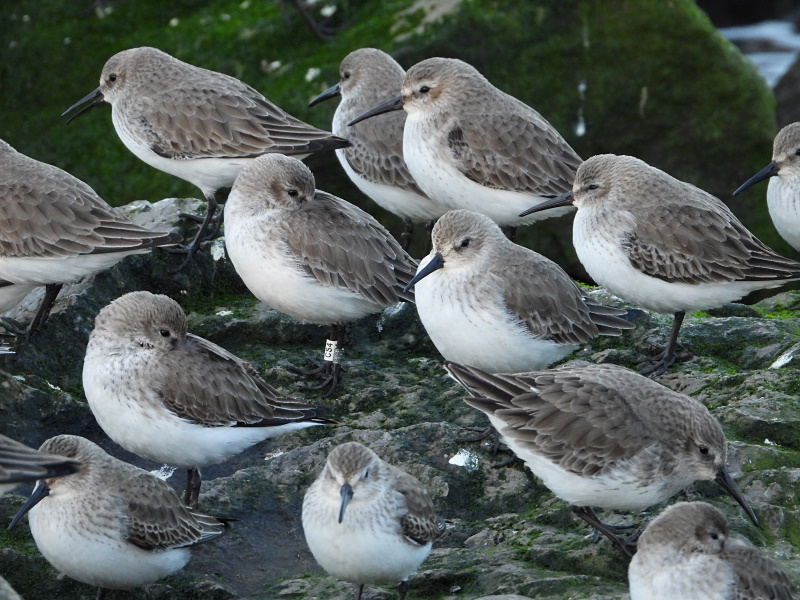
Ringed Dunlin (centre) was ringed in Gdansk, Poland
But perhaps the time we most look forward to is
migration, when the Dunlin are going to and from their breeding
grounds.
These are mostly birds breeding in Greenland and Iceland which winter
in West Africa, and pass through here on their way north in May and
return in August. At this time they are in full breeding plumage and
make for a fantastic sight often carpeting Hoylake shore. The
requirements of these passage birds must be different to the
over-wintering birds as they are rarely seen on the thick mud in the
inner estuary but much prefer the wet sand* found off north Wirral and
between Point of Ayr and Gronant. It's presumably why these passage
birds are virtually absent on the Mersey, with it's thick mud, yet love
the extensive sand banks of Ribble/Sefton coast (the site designated as
the 'Ribble Estuary' for WeBS includes the huge area of sand going from
just north of Formby at Ainsdale all the way past Southport and RSPB
Marshside most of which is not actually in the Ribble Estuary proper -
as you can see in the map above). These passage Dunlins seem to be more
tolerant of human disturbance than the over-wintering birds and many
will come to within a few feet of watching birders as they forage for
food on the beach.
* in reality this could be described as a patchwork
of sand, muddy sand and sandy mud! But the thick estuarine mud found in
the inner estuary (for example off Thurstaston) is largely absent.
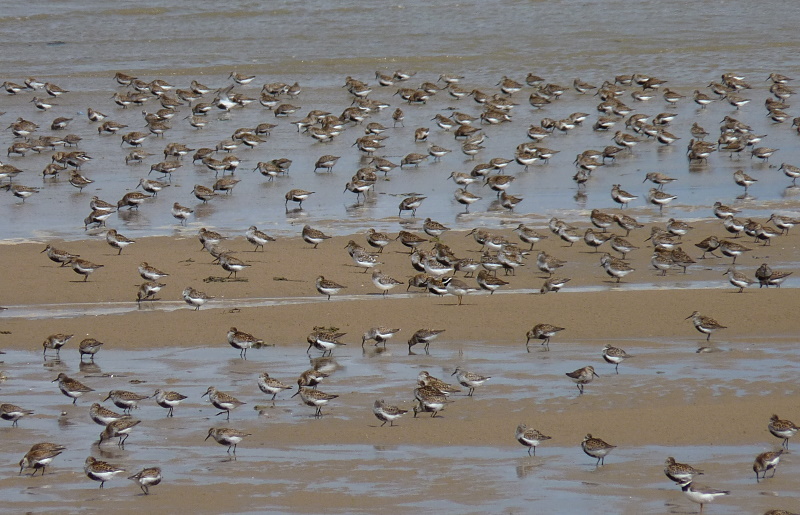
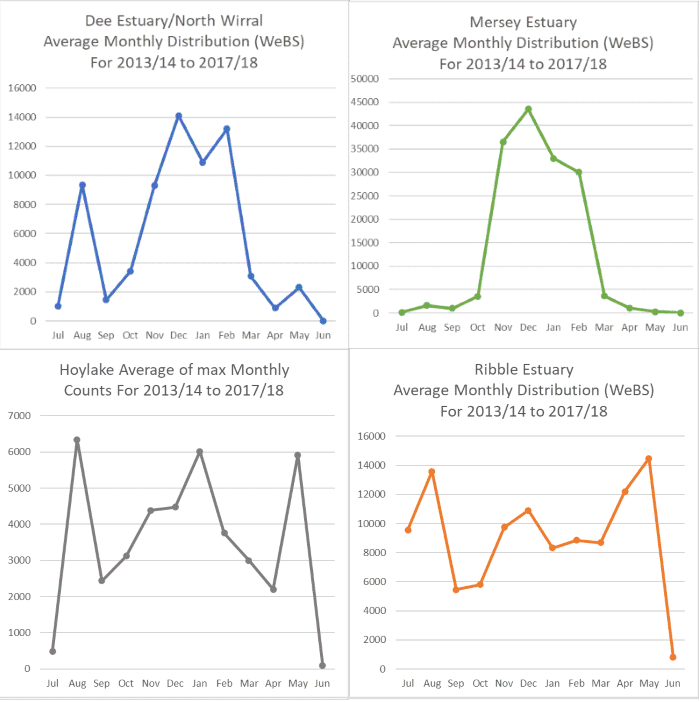
The monthly distributions above tell the story. Numbers do peak on the
Dee in winter but the graph shows the sizable numbers coming through in
May and August which are largely absent on the Mersey. The sand of East
Hoyle Bank off Hoylake (included in the Dee Estuary WeBs counts) and
the large stretch of sand stretching along the Sefton Coast past
Southport to the Ribble attracts thousands of Dunlins on passage.
Recent large counts
of passage birds include 24,232 on the Dee Estuary in August 2014 and
33,006 on the Ribble in August 2018.
There is a lot more to be said about the Dunlin and
next
month I will publish a second article called "Dunlin - Rings, Races and Genes".
References
1. On-line Wetland Bird Survey data - https://app.bto.org/webs-reporting/.
2. Cheshire and Wirral Bird Reports 2013 to 2018.
3. Lancashire Bird Reports 2013 to 2018.
Richard Smith.
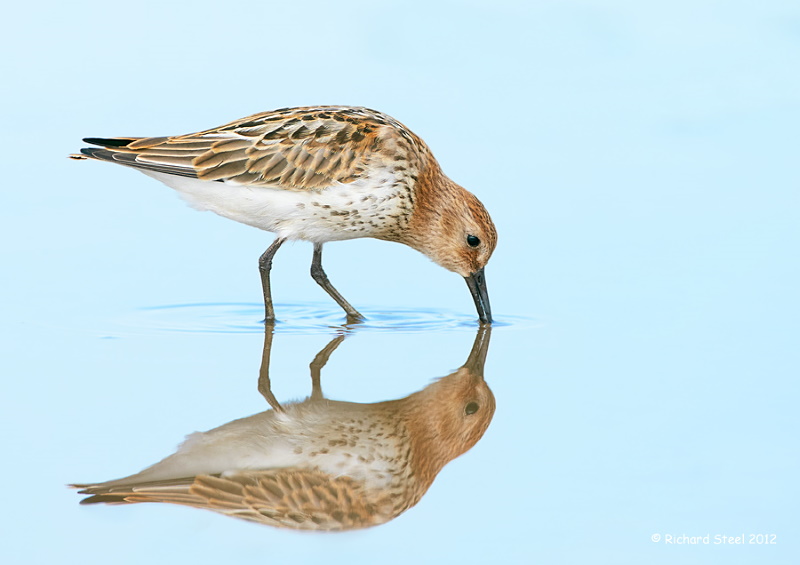
Colour Ring Report
Some particularly interesting ones this month,
including news from South Africa.
Sandwich Terns
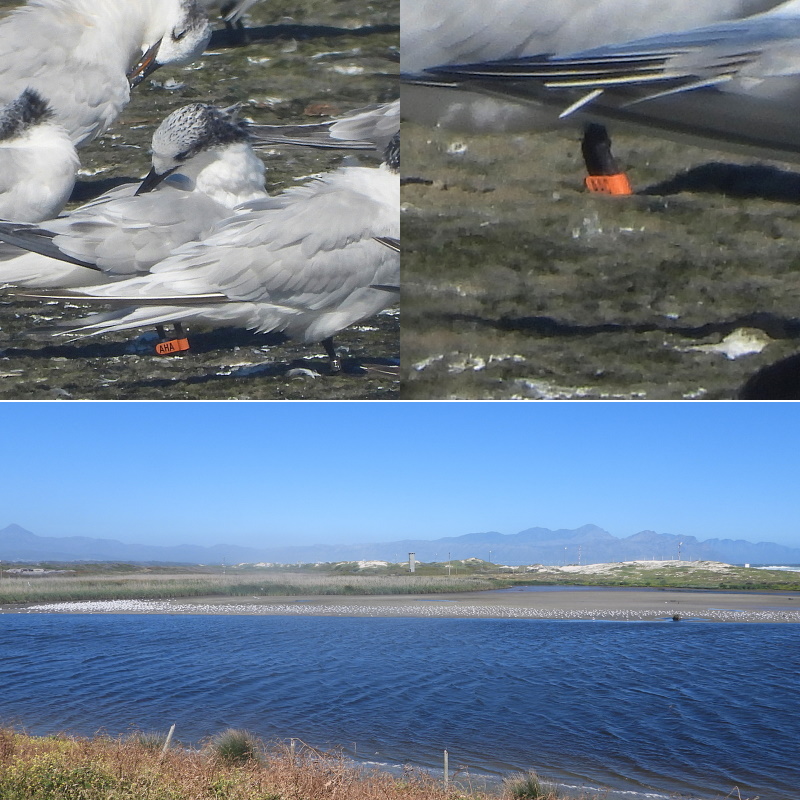
Bottom: View of the Sandwich Tern roost at Macassar, just south of Cape Town SA
photos by Theuns Kruger (October 2020)
Two orange flagged Sandwich Terns which were ringed at Cemlyn Bay,
Anglesey, in June 2019, were seen and photographed in October at
Macassar, False Bay, which is on the south edge of Cape Town, South
Africa. These were ringed as chicks (124 in total) in 2019 and
will have spent this year, 2020, in African waters. We hope to see
their return next spring.
For more details on this project, and about the Sandwich Terns which
visit the Dee Estuary see:
July 2020 Newsletter 'Sandwich Terns' - http://www.deeestuary.co.uk/news0720.htm
,
December 2019 Newsletter - Colour Ring Report - http://www.deeestuary.co.uk/news1219.htm#second
and
August 2019 Newsletter - Colour Ring Report - http://www.deeestuary.co.uk/news0819.htm#second.
Oflag AHA
Ringed Cemlyn Bay, Anglesey, on 18/6/2019.
Recorded at Macassar, Cape Town, South Africa on 21 and 22/10/20.
Oflag AAC
Ringed Cemlyn Bay, Anglesey, on 18/6/2019.
Recorded:
Ainsdale on 16/7/2019.
Hilbre on 31/7/2019.
Macassar, Cape Town, South Africa on 22/10/2020.
Many thanks to Steve Dodd for forwarding these South
African records and to Theuns Kruger for seeing them in the first place.
Cormorant
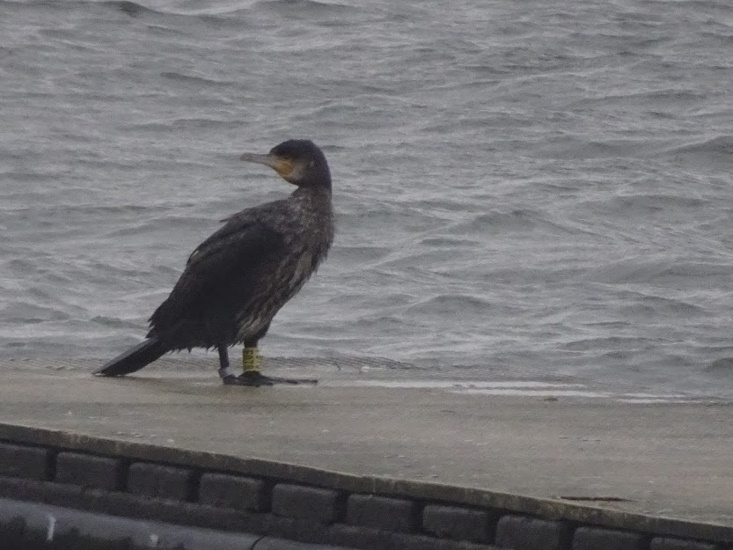
F078 black
on yellow ring.
Ringed at Wasservogelreservat Wallnau, Germany (east coast of Danish
peninsula) on 27/5/2020 as a chick.
Recorded at West Kirby Marine Lake on 22/10/2020.
Only the fourth colour-ringed Cormorant in our
database and the first one ringed outside the UK.
Oystercatcher
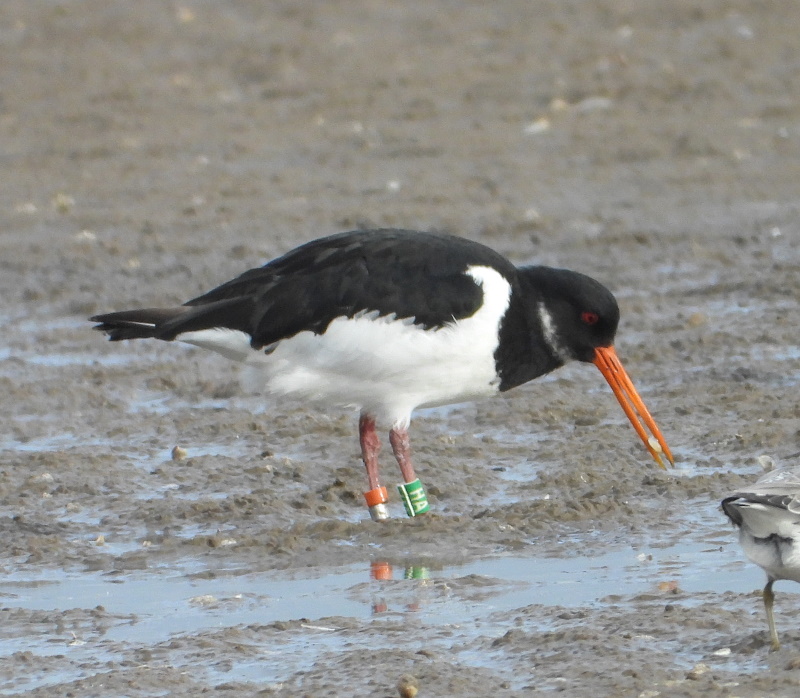
Om-G(HA)
Metal ringed at Caerwys (west of Newtown in mid-Wales) on 26/3/2017.
Colour ringed at Caerwys (west of Newtown in mid-Wales) on 22/3/2020.
Recorded:
Seaforth NR on 5/9/2020.
Meols shore on 4/10/2020.
"This bird was ringed as a breeding adult on an inland site on the banks of the River Severn at Caersws, near Newtown, Mid Wales on 26th March 2017. It was re-trapped at the same site and the colour-ring was added on 22nd March 2020."
Grey Plovers
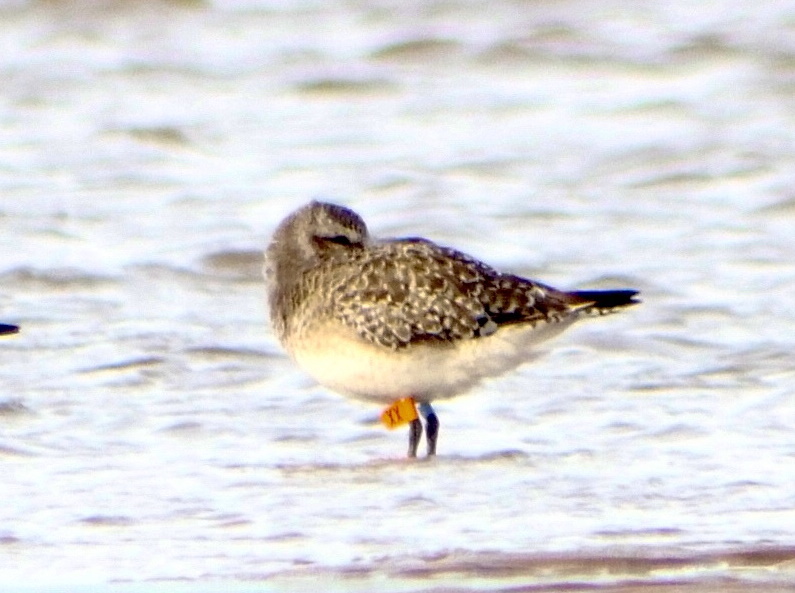
O(XX)-P
Ringed at Altcar on 22/3/2019.
Recorded at Formby in August and Hoylake in September and October 2019.
It was at Ainsdale in February and March, returning to Ainsdale in
September 2020,
Recorded at Hoylake in 21/10/20.
O(LA)-P,
ringed at Altcar on 22/3/2019.
Recorded:
At Formby in April, August and September 2019.
At Hoylake in October 2019 and Hilbre on 24/10/20.
Richard Du Feu, the coordinator for this scheme
says: "Grey
Plovers are one
of the least well understood and studied waders in the UK. From colour
ringing them on the Sefton coast in spring we now know a proportion of
these winter in Brittany".
Shelducks
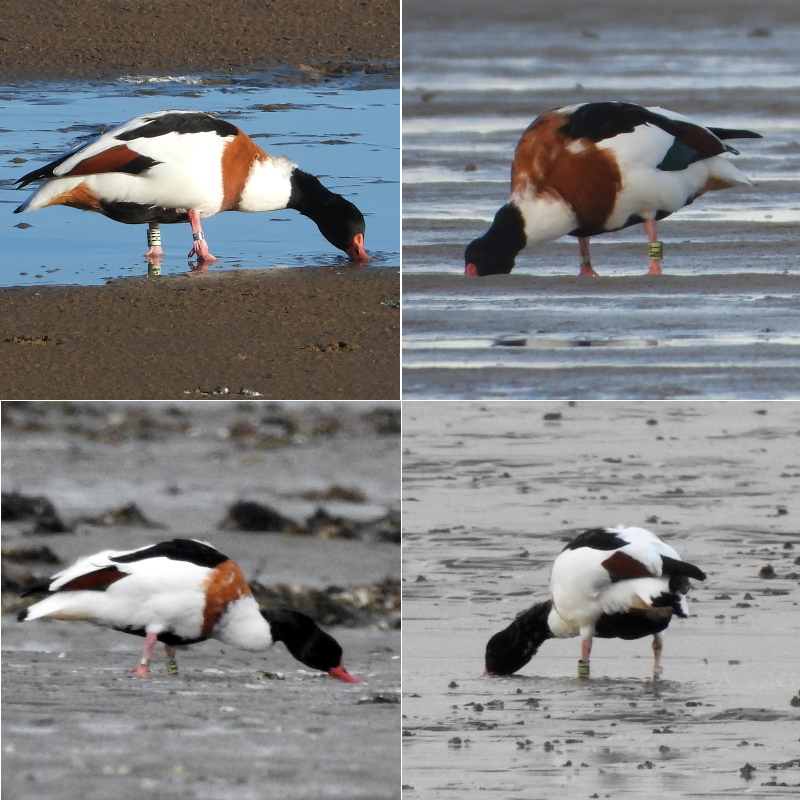
Bottom: Shelducks XR and LJ at Thurstaston © Steve Hinde
During October we recorded another nine Lime ringed Shelducks at
Thurstaston and three at Meols - these were all ringed at WWT Martin
Mere. Good to know we are making a significant contribution to the
study of Shelduck movements in north-west England.
Lesser Black-backed Gull
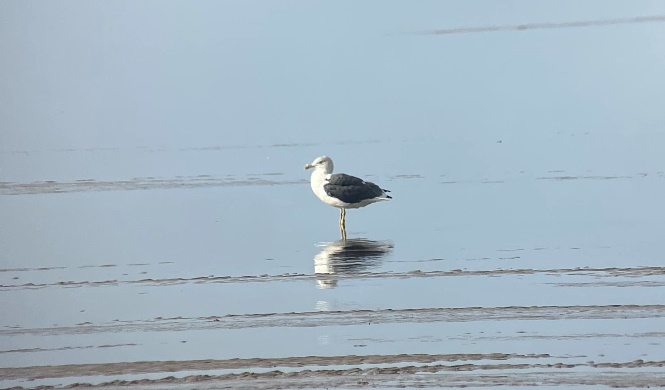
5B:W
Ringed on Walney Island on 1/6/2016 as a breeding adult.
Recorded at Hoylake on 10/9/2017 and 18/10/2020.
Ross Green of the BTO said "It was ringed as part of a
study monitoring movements in relation to offshore wind farms in
the Morecambe Bay area. It was fitted with a GPS tag which tracked its
movement daily between 01/06/2016 and 06/06/2019. This showed
that it moved between Walney and the Wirral, using all coastal areas in
between and traveling no further east than the line between Warrington
and Longridge."
Colour-rings were recorded by Richard Smith, Steve
Hinde, Tim Kinch, Ken McNiffe, Mark Peers, Phil Woolen, Colin
Schofield, Ron Brumby, Colin Jones and Charles Farnell.
October Bird News
If somebody was to tell me just over twenty years
ago when I started this website that people would be sending me bird
photographs of the superb quality as the kingfisher below, and for
free, I would think they were deranged. The pink in the background is
the reflection of the setting sun on the water of Leasowe duck pond.
Fantastic!
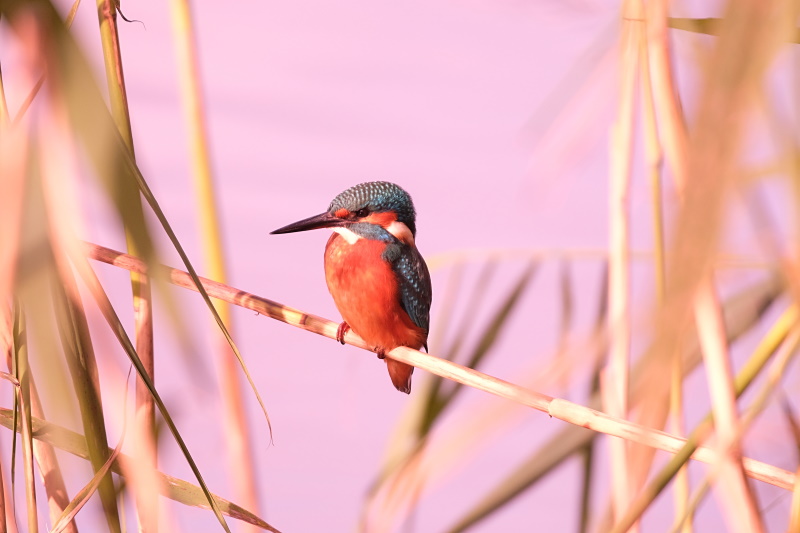
Several Kingfishers were spotted including three at the RSPB Point of Ayr Reserve, they must have had a good breeding season.
There was a good passage of thrushes at Leasowe on
the 14th with 1,000
Fieldfare, 40 Mistle Thrush, 500 Redwing and 25 Song Thrush mostly
heading east. This was no doubt part of a massive movement of thrushes
seen heading over the Yorkshire coast the day before - including 32,080
Redwings and 4,494 Fieldfares! You may wonder why our birds were
heading back east; it had been a clear sky the previous night and they
probably were flying high using the tail wind and overshot ending up
making landfall along North Wales, they would have then flown into the
wind along the coast which was blowing north-east that day.
Unfortunately there were no prolonged north-westerlies to blow in
Leach's Petrels this month but some strong winds on the 10th did bring
in
three adult Pomarine Skuas and an Arctic Tern to north Wirral.
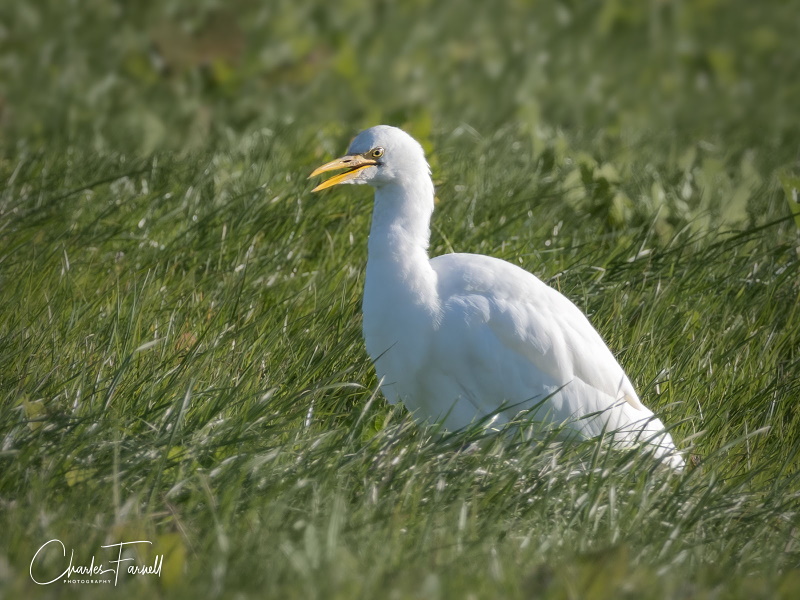
10 Cattle Egrets were at Burton early in the month
and had
increased to a record 13 by the 20th. Four turned up in flooded fields
at Hoylake on the 10th, giving good opportunities for photographs. The
highest count of Great Egrets was at least 24 flying into the roost at
Burton right at the end of the month. There were lots of
Pink-footed Geese around with many flocks seen over Wirral flying
towards the estuary. But the most spectacular sight was seeing
thousands
flying to and from the roost which seems to be off Parkgate at the
moment - at least 6,000. The highest count of Brent Geese was 269 at
Hilbre on the 13th. At least six small flocks of Whooper Swans were
spotted overhead, max 16, some flying west and others east.
Shelduck numbers were high with 6,500 off Heswall
with 350 at Meols a good number for that site, and Wigeon numbers
reached 4,000 off Denhall Quay.
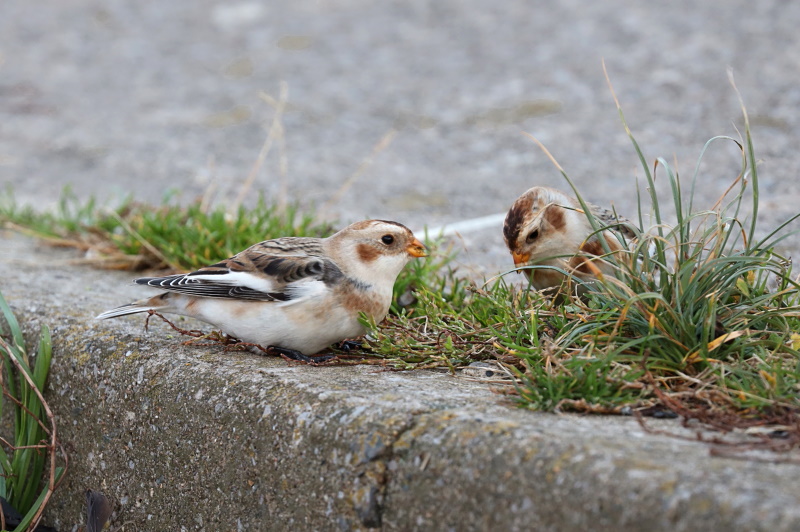
Two Snow Buntings turned up on the embankment to
the east of Leasowe Lighthouse on the 26th before moving west towards
Meols. Also at Meols was a nice Black Redstart.
Other rarities included over-flying Lapland Buntings (two) and a
Richard's
Pipit. A spotted Crake was at Burton Mere Wetlands early in the month.
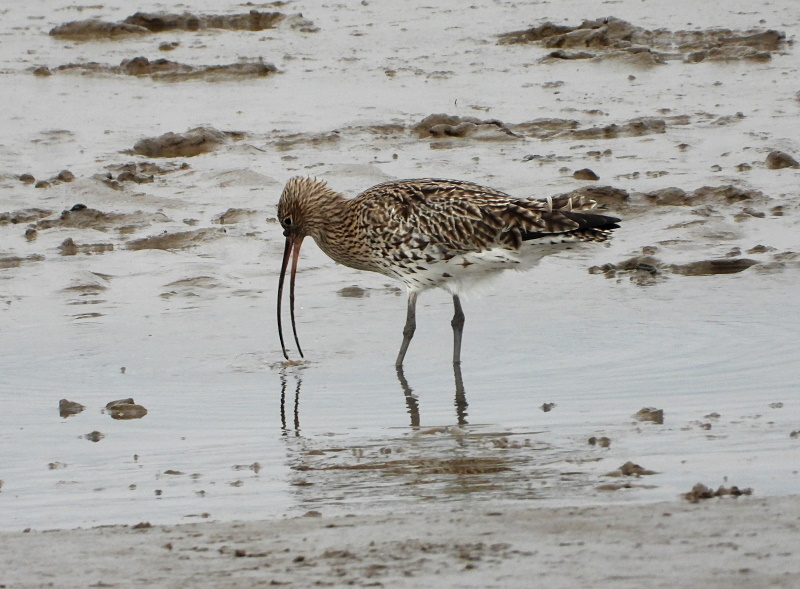
Wader numbers were generally low but 3,000 Black-tailed godwits were at
Caldy early in the month and 4,000 Knot had returned to Thurstaston by
the month-end. At Least 600 Sanderling were at both Hilbre and Hoylake,
a good number for October.
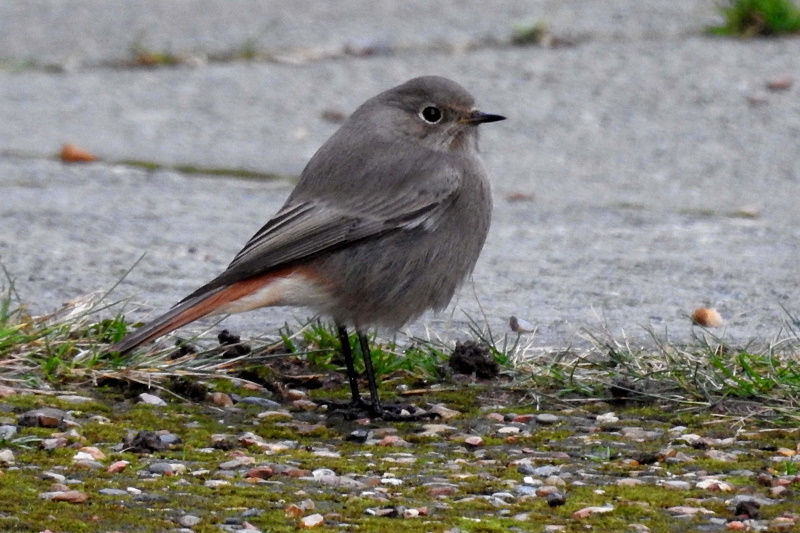
What to expect in November
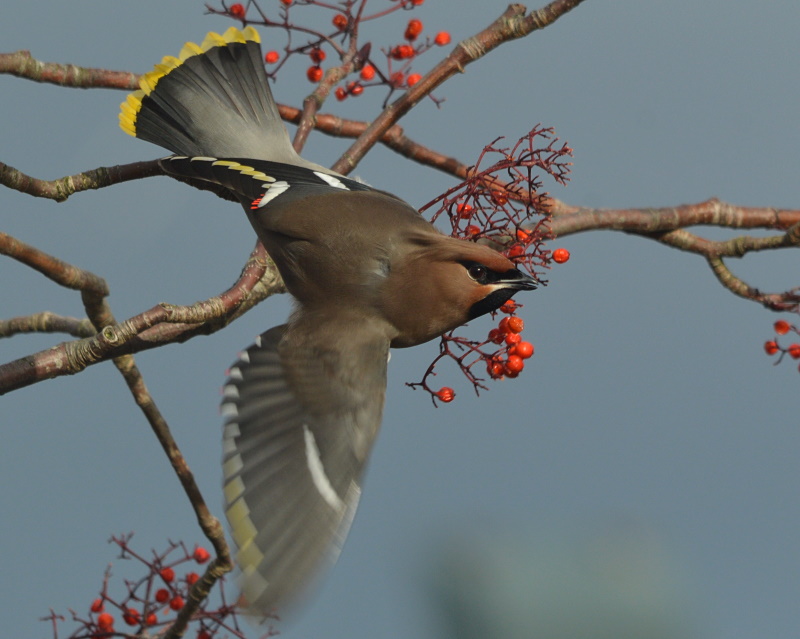
By the end of November we should know if we are in for a good Waxwing winter or not. If it is they will be pouring into Scotland and some may even have reached here. The last big irruption locally, and probably the largest on record for the Dee Estuary area, was in the winter of 2012/13 when Waxwings just seemed to be everywhere - that winter the first ones arrived here on Nov 9th.
Look out for diving ducks on West Kirby Marine Lake.
The most common ones these days are Goosanders (see Goosanders
on the Dee Estuary Aug 2020)
and we could get as many as 10 with a few Red-breasted Mergansers and
Goldeneyes, a Red-throated or Great Northern diver is also a
possibility. On a calm day look out to sea and there may well be
thousands of Common Scoters and hundreds of Great Crested Grebes with
Point of Ayr,
Hilbre and anywhere along north Wirral good places to spot these - they
are likely to be distant so you will need a 'scope.
Judging by the large numbers of Knots on the Wash in
October we may well get big numbers of them here this winter giving
spectacular displays flying over the mud banks at low tide and at the
usual high tide roosts at Point of Ayr, West Kirby and Hoylake.
November is also a good month to see good numbers of other waders such
as Dunlin and Grey Plovers, as well our regular ducks - Pintail, Wigeon
and Teal.
Pink-footed Geese will be everywhere and they are often seen inland
feeding in the fields, I had them a few yards from my house a couple of
years ago, and the Brent will be showing well around Hilbre and West
Kirby - 300 or so. There's also the possibility of something rarer
including a small flock of White-fronted Geese which do turn up
irregularly, and may be a Bean Goose or two.
Short-eared Owls, Hen Harriers, Marsh Harriers and
hopefully a Bittern or two should be showing over the marshes. A good
spot is the southern end of Parkgate looking towards Neston Reed Bed
late afternoon, last year one or two Bitterns were regularly seen
flying to roost as well as Marsh Harriers in double figures.
Forthcoming Events
November Highest Spring Tides (Liverpool)
Also see Tides page.
15th November, 10.42hrs (GMT), 9.9m.
16th November, 11.27hrs (GMT), 10.0m.
17th November, 12.10hrs (GMT), 9.9m.